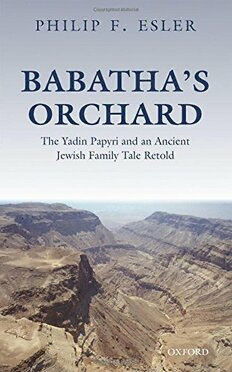Table Of Content’
BABATHA S ORCHARD
’
Babatha s Orchard
The Yadin Papyri and an Ancient
Jewish Family Tale Retold
PHILIP F. ESLER
1
3
GreatClarendonStreet,Oxford,OX26DP,
UnitedKingdom
OxfordUniversityPressisadepartmentoftheUniversityofOxford.
ItfurtherstheUniversity’sobjectiveofexcellenceinresearch,scholarship,
andeducationbypublishingworldwide.Oxfordisaregisteredtrademarkof
OxfordUniversityPressintheUKandincertainothercountries
©PhilipF.Esler2017
Themoralrightsoftheauthorhavebeenasserted
FirstEditionpublishedin2017
Impression:1
Allrightsreserved.Nopartofthispublicationmaybereproduced,storedin
aretrievalsystem,ortransmitted,inanyformorbyanymeans,withoutthe
priorpermissioninwritingofOxfordUniversityPress,orasexpresslypermitted
bylaw,bylicenceorundertermsagreedwiththeappropriatereprographics
rightsorganization.Enquiriesconcerningreproductionoutsidethescopeofthe
aboveshouldbesenttotheRightsDepartment,OxfordUniversityPress,atthe
addressabove
Youmustnotcirculatethisworkinanyotherform
andyoumustimposethissameconditiononanyacquirer
PublishedintheUnitedStatesofAmericabyOxfordUniversityPress
198MadisonAvenue,NewYork,NY10016,UnitedStatesofAmerica
BritishLibraryCataloguinginPublicationData
Dataavailable
LibraryofCongressControlNumber:2016945505
ISBN 978–0–19–876716–9
PrintedinGreatBritainby
ClaysLtd,StIvesplc
LinkstothirdpartywebsitesareprovidedbyOxfordingoodfaithand
forinformationonly.Oxforddisclaimsanyresponsibilityforthematerials
containedinanythirdpartywebsitereferencedinthiswork.
For Patricia, Dominic, Thomas, and Sinéad
Acknowledgements
In2013,priortomytakingupthePortlandChairinNewTestament
Studies at the University of Gloucestershire, I started work on two
newresearchprojects.OnewasEthiopic1stEnochandtheotherwas
theBabathaarchiveoflegalpapyrifrom94to132CE.Thisbookarises
from my realization of the extraordinary and remarkably neglected
riches to be found in the Babatha archive. I well remember my
increasing excitement in those early months in 2013 as I worked
throughitsthirty-fivepapyrionebyone.Previouslytheyhadmainly
attracted research on their legal dimensions. I was extremely taken,
however, by the extent to which they allowed direct access to the
socialworldofNabateaandJudea,includingtheeventsinoneDead
Sea town in 99 CE. This was the period in which some of the New
Testament texts, such as the Gospel of Matthew, would have been
appearing.Asanerstwhilelawyer,Ifoundmyselfcontinuallycaught
up in the usual drama of opportunity for, or threat to, named
individualsthatrequiredlegalinterventionintheformofcommercial
agreements or documents for legal proceedings. Such documents
weredraftedbyhighlycompetentlawyers;‘scribes’,tousetheirown
designation.
A number of people have aided me in the process that led to the
completion of this book. Tom Perridge, Senior Commissioning Edi-
torwithresponsibilityforreligionatOxfordUniversityPress(OUP)
inOxford,initiallyencouragedmetosubmitamanuscripttoOUPon
this subject during a conversation at the International SBL Confer-
enceinViennainJuly2014.WhenIdidsubmitadraftmanuscriptin
February2015,heveryexpeditiouslysecuredthreeanonymousreview-
erstoconsiderit.Thosereviewswereextremelyhelpfulinalertingme
torelevantmaterialandinassistingmetodeveloptheargumentand
I am greatly indebted to their authors. More recently, Karen Raith,
AssistantCommissioningEditor,withresponsibilityforreligionand
theologyatOUP,hasbeenveryefficientinassistingoncertainaspects
of the project, especially by arranging for high-quality reproduction
of the excellent photographs that accompanied the original publica-
tion of the papyri in 2002. I am grateful to Matthew Humphrys
from OUP who expertly shepherded the manuscript through the
viii Acknowledgements
productionphase,andtoNicolaSangsterforhercarefulproof-read-
ing.Permissiontoreproducethosephotos(fromY.Yadin[2002]The
Documents from the Bar Kokhba Period in the Cave of Letters: Heb-
rew, Aramaic and Nabatean-Aramaic Papyri [Plates]. Judean Desert
Studies. Jerusalem: Israel Exploration Society, Institute of Archae-
ology, Hebrew University and the Shrine of the Book, Israel
Museum), and the Aramaic text of P. Yadin 4 was kindly provided
bytheIsraelAntiquitiesAuthority(courtesyofHillelGeva).
During the course of writing the manuscript, I profited on many
occasions fromrelevant publicationssuggested(and oftenprovided)
to me by Professor Hannah Cotton. Professor Cotton also arranged
formyparticipationattwoconferencesfocusingonlawintheancient
Mediterranean, in Oxford in May 2015 and in Saarbrücken in
September 2015 (which she co-organized with Professor Tiziana
Chiusi). I am very grateful to Professor Cotton for this assistance.
IamalsogratefulforDrAdaYardeni’sadvicetomethatinseekingto
decipherthecursivehandwritingfoundintheNabateanlegalpapyri
it is essential to complete accurate drawings of them. Observing
exactly how the scribe has drawn the letters in a word or words
makes one highly sensitive to the letter forms and to the order in
whichtheywereappliedtothepapyrus.ProfessorJohnKloppenborg
and Dr Giovanni Bazzana offered advice on a number of matters to
do with papyrology and ancient contexts. Dr Mahdi (Abdelaziz)
Alzoubi and Dr Kimberley Czajkowski provided me with copies of
their doctoral theses, from which I learned much. My son Dominic,
freshly returned from ethnographic fieldwork in northern Sri Lanka
forhisanthropologydoctorateatUniversityCollegeLondon,rightly
insistedontheimportanceof‘beingthere’inethnographyandalerted
me to relevant literature. Finally, I delivered papers touching on
aspectsofthisvolumeattheSaarbrückenconference,andtograduate
seminarsintheUniversityofDurhamandKingsCollegeLondonin
early 2016 and gratefully acknowledge feedback I received on those
occasions. Noneof thescholars mentioned here, however, bears any
responsibilityfortheviewsIexpressinthisbook.
My friends at the University of Gloucestershire in Cheltenham,
especially Professors Gordon McConville, Andrew Lincoln, and
Melissa Raphael and Drs Pekka Pitkanen, Adrian Long, and Dee
Carter, welcomed me here in September 2013, were encouraging as
I worked on this book, and have provided a useful sounding-board
for some ofthe viewsexpressed init. I have beenfully supported by
Acknowledgements ix
Professor Shelley Saguaro and her successor Dr David Webster in
their role as Head of the School of Humanities. Library staff at the
university have been extremely helpful in assisting me generally and
in tracking down some of the bibliographic items (especially Anne-
liese Cooke and Jane Shirfield in the library at Francis Close Hall
CampusandDeborahJones-DavisandKateReainrelationtointer-
library loans). My daughter Sinéad read the entirety of the final
manuscript, correcting typographical errors and suggesting numer-
ous stylistic improvements. My wife Patricia and son Thomas read
several sections of the manuscript, alerting me to various errors and
infelicities.
Finally, over the past few years Patricia, and Dominic, Thomas,
andSinéad,havebeenatowerofstrength(andafountoftolerance)
from early 2013 when this project began and to date, a time when
theywereandarebusilypursuingtheirownlives.Asasmalltokenof
mythanksandappreciation,Idedicatethisbooktothem.
PhilipF.Esler
TheUniversityofGloucestershire
Cheltenham
October2016

